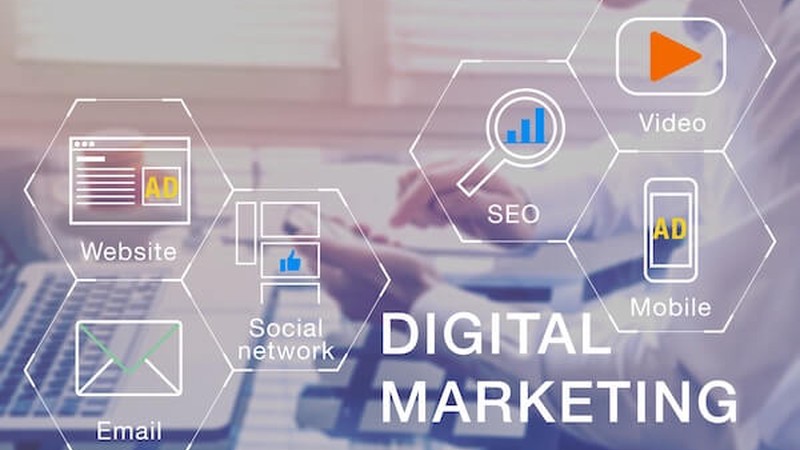Marketing Is Digital: Do You Have the Right Strategy?
Learn ways you can create a digital-first marketing strategy that will effectively help build your brand and your audience at a low cost.

This blog post was originally published in March 2020, and was revised in July 2023.
Adults in the US spend a significant amount of time online. Data show that the time spent on internet-connected mobile devices and apps is only increasing.1 That means opportunities abound for reaching a growing audience. Digital-first marketing strategies tap into these audiences and allow organizations to craft their online brands at low cost.
Traditional thinking suggests an organization’s marketing strategy should be based around television, where the audience is broad and the investment sizable. However, as more and more people spend time online—whether shopping, streaming, or socializing—it is time for a change in that old-school thought process. Your audience is increasingly digital and mobile, and a digital first approach allows you promote your brand to people on the go. Your content needs to be nimble, engaging, digestible, and sharable. Digital-first is a general, overarching strategy that can be deployed on several digital fronts.
Examples of Digital-First Marketing
A digital first strategy can take many forms so there is no one-size-fits-all solution. It all depends on the size and scale of your organization. A good digital marketing strategy should adapt to meet the goals of your business at the lowest cost and best return on investment. If you work at a small bootstrapped startup, your marketing budget may be minimal. At a large corporation, you’ll have the resources to invest in more. In either instance, you will want to include some key elements:
Lead with Digital Content
In 2017, Harvard Business Review (HBR) nixed its direct-mail campaigns for a digital-first model. They used content to drive visitor engagement. With subscriber-only content tools and resources, HBR also leveraged its visitor engagement. This created a one-two punch strategy of engaging content with a targeted social media strategy that ultimately led to an 11.8 percent growth in paid circulation and a 9.5 percent increase in subscriptions in its first year.2
Social Media Customer Service
The intuitive way to use social media is to drive audiences to a specific site, like a landing page or piece of content. You may hesitate to over-post at the risk of appearing too self-promotional. But an effective way to engage directly with individuals is through customer service. Massive companies like airline JetBlue not only respond to customer service requests for issues like glitches or re-scheduling, but they interact on a more casual level too, replying to Tweets with gifs and witty comments. The company has a presence and personality on social media that helps to boost brand loyalty.
Video Marketing
Google ran an experiment last year. In the two weeks leading up to the launch of its Pixel 3 smartphone, Google used two strategies, each one week long, targeting 18–49-year-olds. The first week, it ran ads only on TV and none on YouTube. The second week it did the opposite: it ran ads only on YouTube and none on TV. Data showed that Google’s digital first strategy was more effective. The YouTube campaign’s reach was 36 percent higher than the TV campaign.3 Video is very much a bang-for-your-buck situation. Low production costs, creative dialogue and copy, and catchy effects and editing can reach a wide audience, play well on social media channels, and boost your potential for viral content.
Integrating Digital First with Traditional Media
There is plenty of room to have the best of both worlds: traditional and digital media strategies. Why limit yourself to just one? Traditional and digital approaches (both of which we teach in our Marketing curriculum) can and should complement each other, having a consistent brand voice, but adapting to the channels, platforms and audience. With integration, you can cast a wide net or use laser focus, all the while using online performance metrics to measure the success and effectiveness of targeted campaigns.
Take Apple, for example. Innovative marketing has been a major element to the tech giant’s success since the early days of Steve Jobs. Its various campaigns throughout the years have translated pretty seamlessly from the TV to the web. Often juxtaposing vibrant colors with sleek black and whites, keeping dialogue and messaging as simple as possible, and connecting with people on a personal level, Apple’s campaigns catch peoples’ eyes on TV and engage them online. They reinforce their expertise in design and user experience with their matching sleek retail outlets.
Some estimates suggest on average, 45 percent of marketing budgets will be devoted to digital.4 That percentage only stands to grow in the future, especially as companies become more dexterous with their use of data and statistical analysis. Integrated marketing offers you a bridge between audiences, by combining content, digital and website marketing, with traditional marketing methods like television advertising and public relations.
If you want to learn about digital marketing as it applies to real-world, experiential scenarios, the SMU Cox School of Business Online MBA Program can lead the way. We understand the ever-evolving digital media landscape and our full curriculum is based on foundational pillars of readiness and success, grounded in complex problem solving, creativity, people management, and critical thinking. This combination of theory and application in our live interactive courses will prepare you for the challenges both inside and outside the classroom. Request more information today to learn about how the SMU Cox School of Business community, be it an online program or another graduate programs, can help you achieve your personal and professional goals.
- https://www.nielsen.com/us/en/insights/article/2019/us-consumers-are-shifting-the-time-they-spend-with-media/
- https://www.forbes.com/sites/tonysilber/2018/06/29/harvard-business-review-pivots-to-a-digital-first-marketing-model/#953eccc22954
- https://www.thinkwithgoogle.com/marketing-resources/data-measurement/digital-first-strategy/
- https://www.webstrategiesinc.com/blog/how-much-budget-for-online-marketing-in-2014